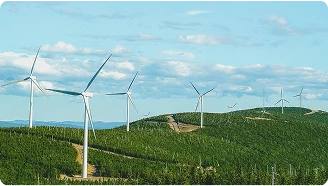Wind Power
Learn how we harness the power of the wind to generate renewable energy. Our goal is to meet Québec's energy needs while contributing to a sustainable future. Find out more about our initiatives and our approach!

Wind power unlocks Québec's energy potential
In line with its Action Plan 2035 – Towards a Decarbonized and Prosperous Québec, Hydro‑Québec is implementing strategies to meet the challenges of the energy transition. This includes adding 10,000 megawatts (MW) of new wind capacity over the next ten years.

Did you know?
-
Québec has more than two decades of experience in wind energy.
-
There are currently 44 wind farms operating in Québec.
-
The current installed wind power capacity is approximately 4,000 MW.
-
By 2035, 10,000 MW of wind power will be added—enough electricity to supply over two million households.
Advantages of wind power
-
Complementary to hydroelectricity
-
High output in winter when demand is highest
-
Rapid deployment
-
Affordable costs
Collaboration is key in wind energy projects
Our teams work closely with communities to design and develop projects that will have a positive local impact.
Prioritizing large-scale projects
To meet growing electricity demand and reduce costs through economies of scale, we need to prioritize projects with more than 1,000 MW of installed capacity. As a leader in energy development, Hydro‑Québec will play a key role in the implementation of large-scale wind projects.
Interested First Nations and other municipalities can now participate in projects as partners. To date, we have announced three wind energy partnerships:
A consistent approach to standard‑scale projects
To complement large‑scale projects and respond to different regional realities, it will be important to maintain the flexibility to implement standard‑scale projects. Industry partners will participate in these projects, which will be comparable in size to those of the last 20 years. Competitive bidding will remain the preferred approach for projects with an installed capacity of up to approximately 350 megawatts (MW). Hydro‑Québec will ensure that there is community support for wind energy projects in advance.
Frequently Asked Questions
Wind energy project model and social acceptance
Our teams and partners–including First Nations, municipalities and Québec's wind energy industry–have developed the expertise needed to implement wind power projects. By working together, we will successfully achieve Québec's energy transition.
Hydro‑Québec and its partners expect these projects to bring significant benefits to First Nations communities and local host regions, including job creation, long-term financial returns and diversification of revenue streams.
In addition, as a government‑owned company, Hydro‑Québec's participation ensures that all Quebecers benefit financially from these projects while advancing the province's decarbonization goals.
Social acceptance refers to the support of a group or community for a project, plan or policy, and is established early on in the decision-making process. To achieve social acceptance, Hydro‑Québec's project teams work together to ensure that projects are well integrated into local economic, environmental and social context. This includes giving all stakeholders the opportunity to have a say in project development. We hold information sessions and consultations to address public concerns and incorporate community feedback.
Our teams rely on public participation that is integrated into the environmental approach from the project planning stage. Projects and practices must demonstrate flexibility, innovation and collaboration with communities, First Nations and Inuit partners to ensure that community concerns are addressed.
Environment
We must obtain the necessary environmental permits to build and operate wind farms.
Environmental assessments and mitigation measures are regulated by the Ministère de l'Environnement, de la Lutte contre les changements climatiques, de la Faune et des Parcs (MELCCFP) and take into account environmental impact assessments, public consultations, legal requirements and local site characteristics.
To manage expected environmental impacts, our teams implement avoidance, mitigation and offsetting measures.
Environmental monitoring is conducted during wind farm construction and operation in accordance with government permits.
No. Wind turbines are strategically located to ensure that noise levels near homes do not exceed 45 decibels during the day and 40 decibels at night, which is comparable to the ambient noise in a library.
Hydro‑Québec's project teams and their partners consider the visual impact on the landscape and key visual points of interest as part of the environmental assessments for each project. Visual simulations are created and presented during consultations. This approach aims to reconcile the concerns of local residents with the technical requirements of a project, while contributing to sustainable development and renewable energy production.
Land use impacts
No. There are currently 44 wind farms all over Québec, and many are located in areas popular for moose hunting. In general, no negative impact on hunting success has been reported in wind farm areas.
Yes, they can. Recreational activities such as snowmobiling (on designated trails), skiing and snowshoeing are permitted in wind farm areas as long as people follow existing regulations and have permission from the landowner.



